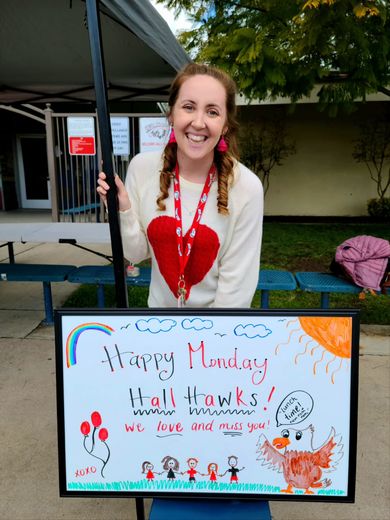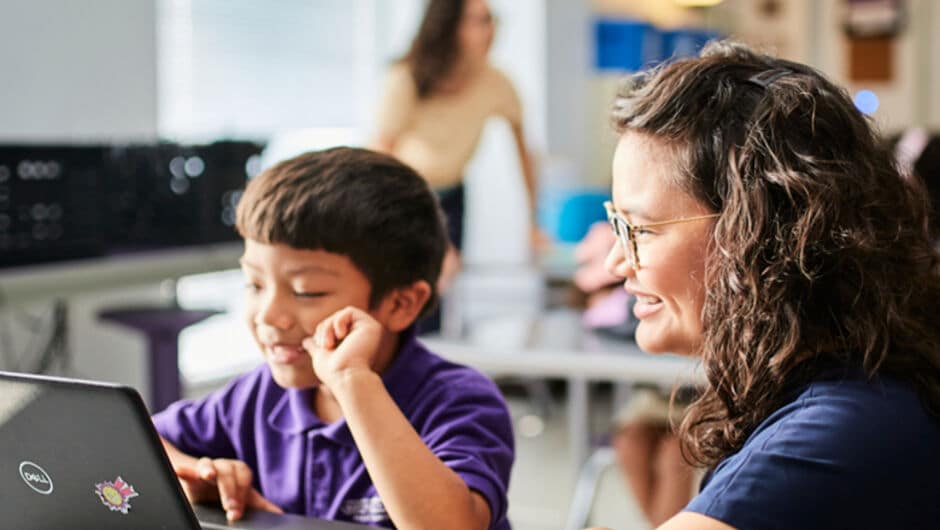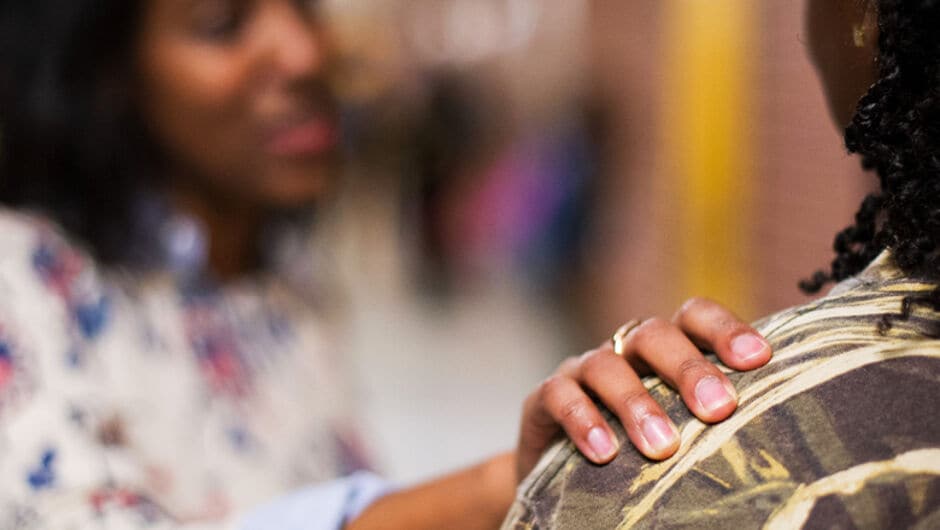
Keeping Students at the Center in the Time of Coronavirus
Teachers and school leaders across the Teach For America network are doing what they do best in this time of social distancing: Supporting students with hope and purpose.
On an ordinary school day, teachers are focused on meeting their students’ needs—academically, emotionally, and in so many other ways. These may not be ordinary times, but those needs remain.
With thousands of schools closed in response to the COVID-19 pandemic, educators are rising to the occasion by going above and beyond typical job duties to keep school services running virtually and make sure students can continue learning.
On top of that, they are finding innovative ways to offer the support and care they've always provided beyond the curriculum and job description to make sure their students—especially those who are already vulnerable during moments of crisis like this—aren’t left behind.
Over the past few weeks, teachers have become overnight PreK YouTube stars and virtual reading partners. They are helping their colleagues manage stress and sharing detailed disaster-response plans on social media. Even superintendents are putting their teaching hats back on to make sure kids get 30 minutes of math every day while schools are closed.
While so much remains uncertain about what the future holds for the remainder of the school year, educators are going the extra mile to support students and families and help provide some sense of normalcy at a time when everything has been turned upside down. (These actions were generally optional and participants were careful to take precautions and follow local guidance around social distancing; some of these events took place before more intense social distancing guidelines became the norm more recently.)
Here are just a few of their stories.
Meeting Basic Needs, One Bus Stop at a Time
In Edgecombe County, North Carolina, schools are a lifeline for services and support for students spread out across rural communities. So what happens when that lifeline gets disrupted by school closures?
The North Edgecombe High School is teaming up with neighboring Phillips Middle School along with the district’s bus drivers to ensure students have the food and supplies they need to continue learning.
Every morning a team of staff and teachers board yellow school buses and travel down back roads, making stops along the bus route to deliver lunch and breakfast for the next day. Nearly half of the students lack reliable access to the internet or devices for remote learning at home, so teachers also bring printed copies of homework and assignments for the coming weeks.
Stephen Ucheomumu (Eastern North Carolina ‘18) teaches sixth- and seventh-grade math at Phillips Middle School and hopped on the school bus to deliver breakfast and lunches to students last week. He says students got excited when they saw the bus coming.
“It was really cool seeing kids coming out and just being so happy to see us. These are the moments that have me deeply reflecting on what I am really here to do,” Stephen says.

When North Edgecombe High School Principal Donnell Cannon (Eastern North Carolina ‘12) put out the call for staff from his school to volunteer for bus deliveries, so many teachers and staff raised their hands that he had to turn some away.
“Every person in this building is on the hook for kids and believes in the magic that we can create together even in tough moments,” Donnell says.
The school teams aren’t just delivering school meals and homework packets. With the nearest grocery store located miles away from some communities, many families rely on the school’s on-site pantry for emergency necessities and groceries. So the school community is stepping up to fill that need too. After receiving several calls from parents, Donnell has been making home deliveries.
“We are delivering food from our pantry so that families don't have to worry about where their next meal is coming from,” he says. “And so our kids aren't experiencing the weight of this painful moment because they're not in school.”
In addition to running bus deliveries, teachers at both schools are also hustling to make sure students’ academic needs are met, in a new online environment. Kadijah Jordan (Eastern North Carolina ‘18), teaches sixth and seventh grade English at Philips Middle School, where her students have made incredible gains this year. She’s worried about what this moment means for students who are still catching up.
“I'm a bit leery because I know my kids have reached strong goals for reading, but I don't know how the rest of the year is going to look—and then going into next year,” Kadijah says. “Is their regression going to show? I’m just trying to find ways to help maintain that proficiency.”
Like many teachers, Kadijah is finding creative ways to get learning opportunities in front of her students. In addition to Google classroom, she’s created an Instagram account that students can follow for quick tips on reading and video lessons on how to analyze a poem. She also runs a weekly Tik Tok challenge with students as a way to keep them engaged and stay connected.
While nothing could have prepared her for this moment, Kadijah says that teachers are always rolling with the punches. “We were like, okay, well what do we do to get our kids what they need?” she says.
Delivering Unexpected Compassion
After receiving the news on a Sunday evening that school would be closed for a few weeks starting the next day, Michelle Quintero and her fellow teachers had a hunch that some families would not get the message in time. So Michelle, along with Mallory Vaughn, and Courtney Clark—all 2018 Las Vegas corps members—met up at William K. Moore Elementary School early on Monday morning and hatched a plan.
They gathered anything they could find in their classrooms that would be useful for students, including books, crayons, colored pencils, markers, and worksheets. The three teachers organized everything into goodie bags and waited outside the school.
“I think we mostly went with the intention to let parents know that school was closed, in case any kids showed up,” Michelle says. “But I think once we were there, we were like, let's mobilize and do something—just grab what we have and do what we can.”
Sure enough, just before the first bell rang, they saw two families pull into the parking lot, checking to see if the school was closed. After handing out the goodie bags to the students, Michelle and her fellow teachers decided they should also canvass the neighborhood as well.

They went around to the nearby apartment complex where many students live and taped up flyers with information about where families could pick up school lunches. They even stopped by a few of their students’ homes to drop off goodie bags and offer some reassurance for anxious families from a safe distance.
“If I'm feeling stressed, I can only imagine how kids feel too when they don't know what's going on,” Michelle says.
Mallory Vaughn teaches second grade at William K. Moore and spent the past week putting together packets to get her students through the next few weeks. She also included some pre-addressed envelopes with postage so kids can send her letters. She hand-delivered the packets to her students’ mailboxes so they would have them immediately. Like many teachers, Mallory says that maintaining a connection with her students and families is an important role that teachers can play at this moment when life as we know it has been disrupted.

“I know a lot of the kids are not getting their regular meals. They're not in their normal safe place. So if I could give them some comfort, I'm all about comforting the kids in any way that I can.”
Twin Teachers Double Down on Love and Joy
Twin sisters Michelle and Melissa Stencil are both 2016 San Diego alums and teach kindergarten at W. D. Hall Elementary. After their school closed on March 13, they jumped at the chance to volunteer for the school’s lunch distribution.
“We know that education encompasses so much more than just the six to seven hours that you are with your students at school,” Melissa says. “And so anytime we get to be a part of something extra in their lives, we always take the opportunity to do that.”
Many of the students who attend W. D. Hall come from immigrant families and don’t have a lot of resources to draw from. The district has also made lunches available for students with younger siblings so that they are getting something to eat as well.
Michelle and Melissa showed up at their school with cheerful handmade signs and greeted parents and children with big smiles when they drove up. Melissa says it’s a relief to see kids in car seats wiggling with joy.
“Their whole sense of normal is completely thrown off now,” Melissa says. “But they're seeing that their teachers care about them when they're at school and when they're not at school as well."

Preserving that sense of normalcy for their students is top of mind for the two sisters. At the moment, it’s optional for teachers to send work home to their students while the district rolls out a formal plan for online learning. But the two sisters know how important it is to maintain contact with their students and remind kids that they are still there for them right now.
So Melissa and Michelle put together a sample schedule for parents with some of the classroom routines that are familiar to students and can be done at home, such as daily writing prompts for morning journal time. They also send out a written version of their “Friday news,” which includes an activity where students can find sight words.
While the future of learning for the rest of the school year remains uncertain, Michelle says that one of the most important things teachers can do right now is to make sure that students still know that you're there and that you're still their teacher regardless of whether you see them every day or not.
“It's our job as educators to pick up the academic pieces when we come back. Your students don't need to feel that burden. They just need to feel loved and cared for.”
We invite all Teach For America corps members and alumni to join our TFA Network Slack workspace to find resources and support as you respond to the COVID-19 outbreak. And if you would like to share your story of supporting students during this time, please email us.
Sign up to receive articles like this in your inbox!
Thanks for signing up!
Content is loading...








